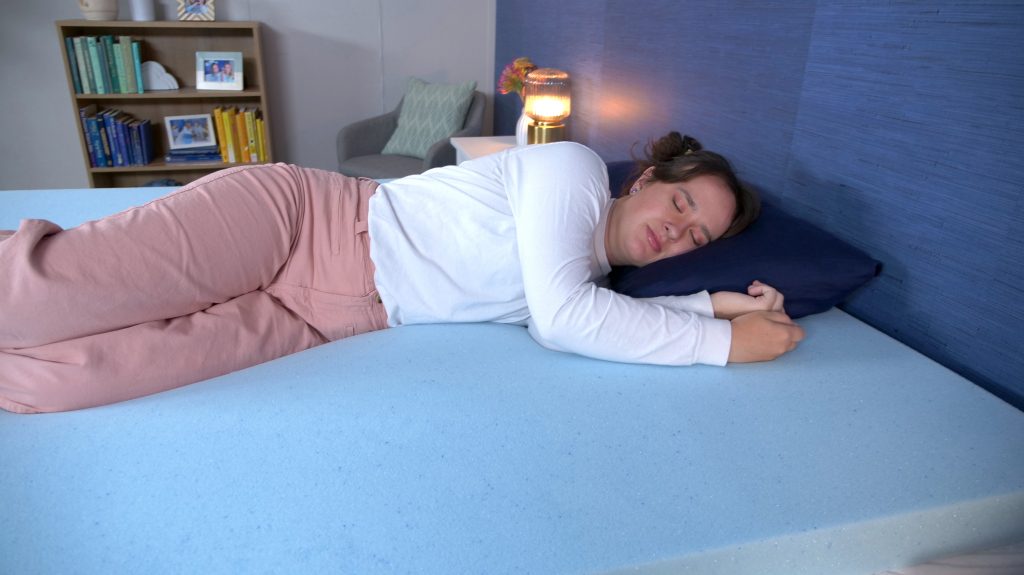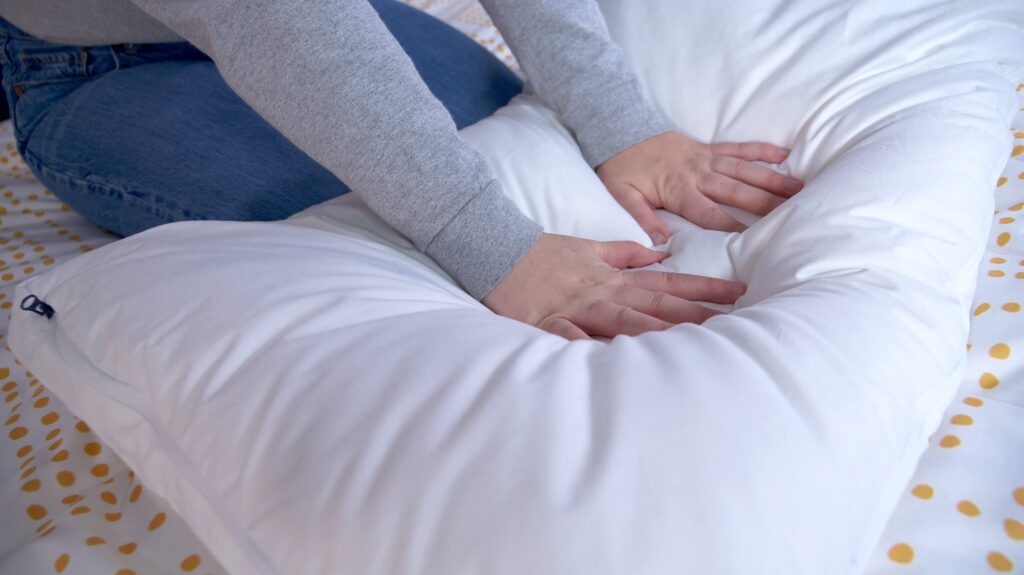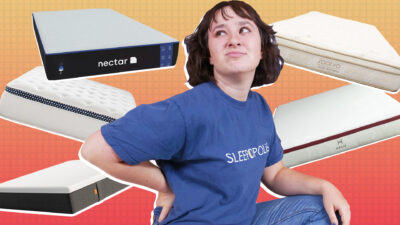The shoulder is a ball-and-socket joint and a hot spot for pressure buildup, injury, and chronic pain. There are a variety of conditions that could cause shoulder pain, but if you can’t point to a specific ailment (like arthritis), your pain could be caused — at least in part — by your mattress. The best mattresses for shoulder pain are better at alleviating and preventing mattress-induced shoulder pain than others, so we’ve put together a list of our favorites.
When it comes to finding a mattress that helps to alleviate shoulder pain, the main thing we look at is its pressure-relieving capabilities. To test this, we put all of our mattresses through what’s called a pressure map test. During this test, we spread out a specialized mat on the mattress and then lie down on it in different positions. The map will record how much pressure we feel in each position, and then put that information into a graphic that shows us exactly how much pressure the mattress is exerting on our joints. Blue and green equate to low pressure, while yellow and red mean that there is quite a bit of pressure building in those areas.
Obviously, when you’re looking for a pain-relieving mattress, you’re going to want to go with one that has less pressure buildup, especially around the hips, shoulders, and lower back. Besides the pressure map test, you can also take a look at the firmness score of your mattress. To test this, we have our Sleepopolis mattress testers take a 15-minute power nap on the mattress, and then we combine the rankings to create our firmness score. Sleepers who suffer from joint pain are most likely going to want to pick a softer mattress (below a 6.5 on the mattress firmness scale).
Keep reading to take a look at our favorite pain-relieving mattresses, and make sure to check out their full descriptions to see if they really are the best option for you.
Our Top Pick For Shoulder Pain
If you have shoulder pain, you’re likely looking for something that will cradle sensitive joints. The Puffy Royal Hybrid fits the bill with several layers of contouring foams, countered at the bottom by supportive coils.
Best Mattresses for Shoulder Pain
- Best Overall Mattress – Puffy Royal Hybrid
- Best Mattress for Neck and Shoulder Pain – Helix Sunset Luxe
- Best Mattress for Side Sleepers with Shoulder Pain – Loom & Leaf
- Best Cooling Mattress for Shoulder Pain – DreamCloud
- Best Hybrid Mattress for Shoulder Pain – WinkBed
- Best Mattress for Heavy Sleepers with Shoulder Pain – Titan Plus Luxe
- Best Mattress for Back Sleepers with Shoulder Pain – Nolah Signature
- Best Mattress for Athletes with Shoulder Pain – Bear Elite Hybrid
- Best Mattress for Couples with Shoulder Pain – Brooklyn Bedding Signature Hybrid
- Best Memory Foam Mattress for Shoulder Pain – Nectar
Disclaimer: Please note that the content in this article is meant for informational purposes only and should not be construed as medical advice or serve as a substitute for seeing a medical professional regarding any sleep problems you may have. Please see your doctor regarding any urgent medical issues.
Best Mattress for Shoulder Pain 2024 Video Review

Compare the Best Mattresses for Shoulder Pain
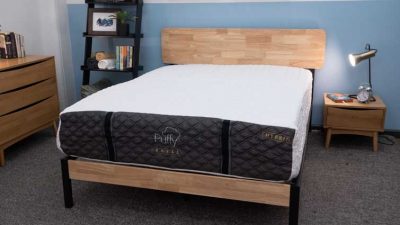
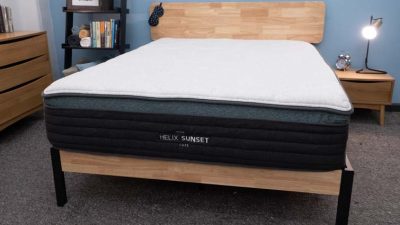
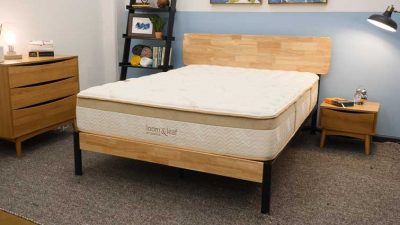
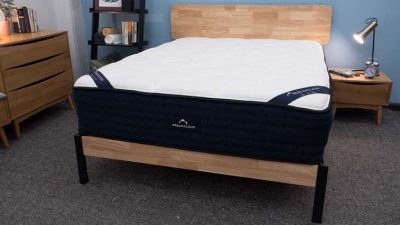

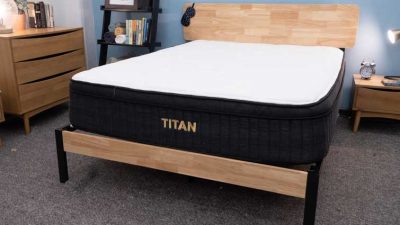
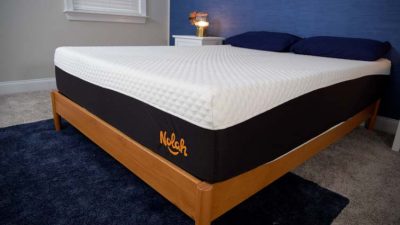
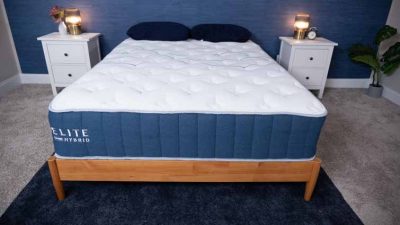
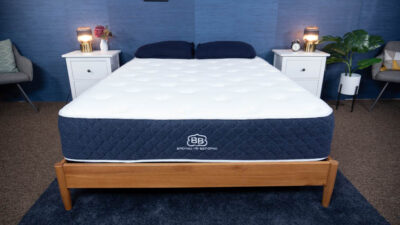
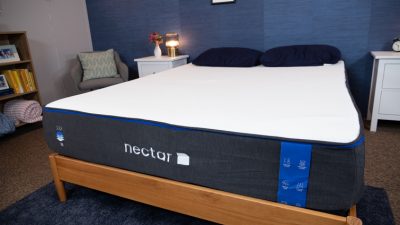
Puffy Royal Hybrid Mattress
Helix Sunset Luxe Mattress
Loom & Leaf Mattress
DreamCloud Original Mattress
WinkBed Mattress
Brooklyn Bedding Titan Plus Luxe
Nolah Signature 12" Mattress
Bear Elite Hybrid Mattress
Brooklyn Bedding Signature Hybrid Mattress
Nectar Mattress
Rating
Firmness
Medium-soft: 6/10
Soft: 5.5/10
Multiple firmness options
Firm: 7/10
Multiple firmness options
Medium-firm: 6.5/10
Soft: 5.5/10
Multiple firmness options
Multiple firmness options
Medium-soft: 6/10
Material
Hybrid
Hybrid
Foam
Hybrid
Hybrid
Hybrid
Foam
Hybrid
Hybrid
Foam
Cooling
--
--
--
✓
✓
--
--
✓
--
--
Sleep Position
Back & Side
Back & Side
Back & Side
Back
Combination
Back & Side
Back & Side
Back & Stomach
Back
Back & Side
Best Overall Mattress Shoulder Pain – Puffy Royal Hybrid
The Puffy Royal Hybrid combines thick layers of slow-response memory foam with individually pocketed coils for a luxurious, contouring feel with just a little bit of bounce.
We recommend this mattress for the following sleeper types: Financing options are available for this mattress. The Puffy Royal Hybrid combines thick layers of slow-response memory foam with individually pocketed coils for a luxurious, contouring feel with just a little bit of bounce.
We recommend this mattress for the following sleeper types: Financing options are available for this mattress. The Puffy Royal Hybrid combines thick layers of slow-response memory foam with individually pocketed coils for a luxurious, contouring feel with just a little bit of bounce.
We recommend this mattress for the following sleeper types: Financing options are available for this mattress.Puffy Royal Hybrid Mattress

Material
Hybrid
Trial Period
101 nights
Shipping Method
Free shipping
Firmness
Medium-soft: 6/10
Warranty
Lifetime warranty
Price Range
$$$$$
Couples
This bed has great motion isolation so you will not feel your partner tossing and turning at night.
Back Pain
This bed is perfect for anyone suffering from back pain.
Back Sleeping
Ideal for lightweight and average weight back sleepers.
Side Sleeping
Ideal for lightweight and average weight side sleepers.
Financing Options
Puffy Royal Hybrid Mattress

Material
Hybrid
Warranty
Lifetime warranty
Firmness
Medium-soft: 6/10
Shipping Method
Free shipping
Trial Period
101 nights
Price Range
$$$$$
Couples
This bed has great motion isolation so you will not feel your partner tossing and turning at night.
Back Pain
This bed is perfect for anyone suffering from back pain.
Back Sleeping
Ideal for lightweight and average weight back sleepers.
Side Sleeping
Ideal for lightweight and average weight side sleepers.
Financing Options

Puffy Royal Hybrid Mattress
Material
Hybrid
Firmness
Medium-soft: 6/10
Trial Period
101 nights
Warranty
Lifetime warranty
Shipping Method
Free shipping
Price Range
$$$$$
Couples
This bed has great motion isolation so you will not feel your partner tossing and turning at night.
Back Pain
This bed is perfect for anyone suffering from back pain.
Back Sleeping
Ideal for lightweight and average weight back sleepers.
Side Sleeping
Ideal for lightweight and average weight side sleepers.
Financing Options
Expert Opinion
If you’re looking for a mattress that works well for shoulder pain, we’d recommend the Puffy Royal Hybrid. This is a luxury mattress that combines both foams and coils for a good balance of body contouring and mobility. When testing it out, we felt shoulder pressure alleviated at the get-go, thanks to a Cooling Cloud Foam comfort layer that allows you to sink in and get immediate relief in more sensitive areas.
We think the plush feel of this mattress should allow for deep sinkage and shoulder pain relief, no matter what sleeping position you prefer. We measured this in our pressure map test, which is where we lay a special mat over the mattress and use thermal imaging to measure how much pressure we feel during back and side sleeping. We found that side sleeping lit up the graphic almost completely blue (equating to low pressure in the shoulder and hip areas).
What our tester says: “I really like the soft memory foam layers of this mattress. It’s a great fit for side and back sleepers or folks who suffer from joint pain. Puffy also offers a memory-foam feel without trapping too much body heat.” – Logan Block, former Sleepopolis director of content and mattress tester
What Customers Say
Multiple reviews on the Puffy website talk about how plush this mattress is. These customers loved the soft feel they got from the Puffy Royal Hybrid, and many stated that they woke up with virtually no back pain, which was a problem on their previous mattress.
Pros of the Puffy Royal Hybrid Mattress
- This is a great mattress for back pain, which we can see in the pressure map test. During this test, back sleeping lit up completely blue, proving that back sleepers should feel that their weight is evenly distributed, helping to alleviate pain in this area.
- Memory foam mattresses have a bad rep when it comes to cooling, but the Puffy Royal Hybrid helps to break this stigma. This mattress includes a breathable polyester cover, Cooling Cloud Foam, Climate Comfort Foam (which is resistant to temperature and humidity), and cooling gel throughout all of the memory foam layers. The coils in the base layer of this mattress also add some airflow.
- Back sleepers should enjoy this mattress because of the body contouring that it offers around their pressure points. This gives the mattress a “hugging” sensation, which is great for filling in the space around the lumbar region.
Cons of the Puffy Royal Hybrid Mattress
- The Puffy Royal Hybrid definitely has more of a “sinking” feel to it, rather than an “on top” feel. Because of this, combination sleepers might want to opt for a mattress that allows them to switch positions more easily during the night. We recommend that these sleepers check out our roundup of the best mattresses for combination sleepers.
Ready to try out the Puffy Royal Hybrid? Click here to see our latest deals. You can also earn more in our full Puffy Royal Hybrid mattress review, or check out some other choices in our roundup of the best mattresses.
Best Mattress for Neck and Shoulder Pain – Helix Sunset Luxe
The Sunset Luxe is the softest model in the Helix Luxe line. A combination of soft Memory Plus foam and springy Helix Dynamic Foam create a soft yet responsive feel. Regardless of your preferred sleeping position, you won’t feel swallowed by the foam layers of this mattress.
We recommend this mattress for the following sleeper types: Financing options are available for this mattress. The Sunset Luxe is the softest model in the Helix Luxe line. A combination of soft Memory Plus foam and springy Helix Dynamic Foam create a soft yet responsive feel. Regardless of your preferred sleeping position, you won’t feel swallowed by the foam layers of this mattress.
We recommend this mattress for the following sleeper types: Financing options are available for this mattress. The Sunset Luxe is the softest model in the Helix Luxe line. A combination of soft Memory Plus foam and springy Helix Dynamic Foam create a soft yet responsive feel. Regardless of your preferred sleeping position, you won’t feel swallowed by the foam layers of this mattress.
We recommend this mattress for the following sleeper types: Financing options are available for this mattress.Helix Sunset Luxe Mattress

Material
Hybrid
Trial Period
100 nights
Shipping Method
Free shipping
Firmness
Soft: 5.5/10
Warranty
15-year warranty
Price Range
$$$$$
Joint Pain
This bed is perfect for anyone suffering from joint pain.
Back Sleeping
Ideal for lightweight and average weight back sleepers.
Side Sleeping
Ideal for lightweight and average weight side sleepers.
Financing Options
Helix Sunset Luxe Mattress

Material
Hybrid
Warranty
15-year warranty
Firmness
Soft: 5.5/10
Shipping Method
Free shipping
Trial Period
100 nights
Price Range
$$$$$
Joint Pain
This bed is perfect for anyone suffering from joint pain.
Back Sleeping
Ideal for lightweight and average weight back sleepers.
Side Sleeping
Ideal for lightweight and average weight side sleepers.
Financing Options

Helix Sunset Luxe Mattress
Material
Hybrid
Firmness
Soft: 5.5/10
Trial Period
100 nights
Warranty
15-year warranty
Shipping Method
Free shipping
Price Range
$$$$$
Joint Pain
This bed is perfect for anyone suffering from joint pain.
Back Sleeping
Ideal for lightweight and average weight back sleepers.
Side Sleeping
Ideal for lightweight and average weight side sleepers.
Financing Options
Expert Opinion
Having both neck and shoulder pain is not a winning combo by any means. If you’re searching for some relief from both of these ailments, look no further than the Helix Sunset Luxe mattress. This is the luxury upgrade of the standard Helix Sunset — the softest model in the brand’s line of hybrid mattresses. With the Luxe, they’ve added a Tencel cover for cooling and a two-inch pillow top for extra pressure relief. We found that the pillow top included in this version of the mattress worked wonders for both neck and shoulder pain. To prove this, we performed a pressure map test on the Helix Sunset Luxe. We found the map lit up completely blue (equating to low pressure).
The Helix Sunset Luxe scored a 5.5 on our firmness scale, which is created using the rankings of multiple Sleepopolis mattress testers. The industry standard for a medium-firm mattress is set at a 6.5, so the Helix Sunset Luxe is much softer than this average. We could really feel the soft foams in this mattress cradling and supporting our sensitive joints. The Helix Sunset Luxe also includes coils that have zoned support, which can help prevent jamming around the hips and shoulders.
What our tester says: “The Sunset Luxe does a great job of temperature regulation thanks to its cooling cover, gel-infused foams, and breathable pocketed coils. The firmness level of this bed means it will offer plenty of plush pressure relief to side sleepers.” – Logan Block, former Sleepopolis director of content and mattress tester
What Customers Say
Customers on the Helix website love the extra-soft and plush feel that they get from the Helix Sunset Luxe. Many users stated that this mattress helped get rid of their back pain completely, especially around their lumbar region. However, some reviews do state that the bed sleeps pretty hot, so sleepers who suffer from night sweats might want to keep that in mind.
Pros of the Helix Sunset Luxe Mattress
- The Helix Sunset Luxe includes zoned support, which allows for more comfort around the hips, shoulders, and lumbar region. This is great for sleepers who suffer from back pain, as this area will receive pressure relief from the gel visco pillow topper and support from the coils in the base layer.
- Lightweight sleepers should be able to rest easily on the Helix Sunset Luxe, especially if they prefer to sleep on their back or side. These sleepers should get the contouring their need around sensitive areas like the hips and shoulders, promoting a healthy spinal alignment.
- Because of the soft nature of this mattress, the Helix Sunset Luxe is a great choice for side sleepers. They should appreciate the pressure relief around their joints during the night.
Cons of the Helix Sunset Luxe Mattress
- Strict stomach sleepers might want to look elsewhere for their perfect mattress. The Helix Sunset Luxe is likely too soft for these folks, as they usually need extra support in order to keep their hips lifted and in line with their shoulders (the key to them maintaining a healthy spinal alignment). We recommend these customers check out our roundup of the best mattresses for stomach sleepers.
Click here for our best deal, or take a look at our full Helix Sunset Luxe mattress review for more info. You can also learn more about the entire Luxe line in our Helix Luxe mattresses review, and check out more options on our best mattresses for neck pain page.
Best Mattress for Side Sleepers with Shoulder Pain – Loom & Leaf
Loom & Leaf Mattress

The Loom & Leaf is a pressure-relieving memory foam mattress. It offers deep sinkage and contouring, and its foam layers absorb almost all movement, making it a great option for couples.
Material
Foam
Trial Period
365 nights
Shipping Method
Free shipping
Firmness
Multiple firmness options
Warranty
Lifetime warranty
Price Range
$$$$$
Loom & Leaf Mattress

The Loom & Leaf is a pressure-relieving memory foam mattress. It offers deep sinkage and contouring, and its foam layers absorb almost all movement, making it a great option for couples.
Material
Foam
Warranty
Lifetime warranty
Firmness
Multiple firmness options
Shipping Method
Free shipping
Trial Period
365 nights
Price Range
$$$$$

Loom & Leaf Mattress
The Loom & Leaf is a pressure-relieving memory foam mattress. It offers deep sinkage and contouring, and its foam layers absorb almost all movement, making it a great option for couples.
Material
Foam
Firmness
Multiple firmness options
Trial Period
365 nights
Warranty
Lifetime warranty
Shipping Method
Free shipping
Price Range
$$$$$
Expert Opinion
Side sleepers are more prone to shoulder pain than any other sleeper since they typically concentrate most of their weight on their shoulders at night. Fortunately, choosing an all-foam bed like the Loom & Leaf can help alleviate this problem. This mattress includes a comfort layer of cooling, gel-infused memory foam in its construction that has a slow response to pressure. This helps side sleepers sink into the mattress for more pressure relief around their hips and shoulders. The contour layer in the Loom & Leaf also includes memory foam, which gives them a pressure-relieving hug.
The Loom & Leaf scored a 6 out of 10 on our firmness test, making this mattress softer than the industry standard for a medium-firm bed. While you most likely will feel yourself sinking into the top layers of memory foam, the transition layer of polyfoam helps to stop over-sinkage, allowing sleepers to more gradually ease into the mattress.
What our tester says: “This bed features two thick top layers of the pressure-relieving material. I think side sleepers should do especially well on this bed as they experience cushiony support at the shoulders and hips. ” – Logan Block, former Sleepopolis director of content and mattress tester
What Customers Say
Users on the Saatva website often comment on how much they love the typical memory foam feel of the Loom & Leaf. This mattress is constructed entirely of foam, so sleepers are able to experience a plush, comfy bed without any coils in the base.
Pros of the Loom & Leaf Mattress
- The memory foam comfort layers included in the Loom & Leaf make it a great choice for seniors, as these sleepers typically need added pressure relief around their joints.
- The Loom & Leaf scored very well on our motion isolation test, most likely because memory foam is a great material for absorbing movement. This makes this mattress a sensible choice for couples because neither person should feel the tossing and turning of their partner during the night.
- The Loom & Leaf includes zoned lumbar quilting in the top layer, meaning that some spots of the mattress are firmer than others. This gives your body support where it needs it the most, and can go a long way toward helping prevent back pain.
Cons of the Loom & Leaf Mattress
- Although the Loom & Leaf does have a few cooling features in its construction, we still felt that it slept a tad hot overall. If you’re prone to night sweats, we recommend checking out our roundup of the best cooling mattresses for some other options.
Click here to see our current deals, or learn more in our full Loom & Leaf mattress review. Still searching? Take a look at our picks for best mattress for side sleepers.
Best Cooling Mattress for Shoulder Pain – DreamCloud
The DreamCloud Mattress is a luxury hybrid mattress made with layers of memory foam and pocketed coils. It offers a great combination of support and pressure relief that back sleepers will really enjoy.
We recommend this mattress for the following sleeper types: Financing options are available for this mattress. I have purchased 5 different Dreamcloud mattresses over the years and never once disappointed. Always fast shipping. Fantastic pricing. But by far the best feature is the quality of the Dreamcloud mattress. Also very impressed with the free bedding (sheets) that came with my recent two purchases. Don’t change what you are doing/offering. It’s perfect in every way.
The DreamCloud Mattress is a luxury hybrid mattress made with layers of memory foam and pocketed coils. It offers a great combination of support and pressure relief that back sleepers will really enjoy.
We recommend this mattress for the following sleeper types: Financing options are available for this mattress. I have purchased 5 different Dreamcloud mattresses over the years and never once disappointed. Always fast shipping. Fantastic pricing. But by far the best feature is the quality of the Dreamcloud mattress. Also very impressed with the free bedding (sheets) that came with my recent two purchases. Don’t change what you are doing/offering. It’s perfect in every way.
The DreamCloud Mattress is a luxury hybrid mattress made with layers of memory foam and pocketed coils. It offers a great combination of support and pressure relief that back sleepers will really enjoy.
We recommend this mattress for the following sleeper types: Financing options are available for this mattress. I have purchased 5 different Dreamcloud mattresses over the years and never once disappointed. Always fast shipping. Fantastic pricing. But by far the best feature is the quality of the Dreamcloud mattress. Also very impressed with the free bedding (sheets) that came with my recent two purchases. Don’t change what you are doing/offering. It’s perfect in every way.
DreamCloud Original Mattress

Material
Hybrid
Trial Period
365 nights
Shipping Method
Free shipping
Firmness
Firm: 7/10
Warranty
Lifetime warranty
Price Range
$$$$$
Hot Sleepers
If you often overheat while you sleep, this mattress should help you stay cool.
Seniors
This bed is perfect for senior sleepers.
Back Sleeping
Ideal for average weight back sleepers.
Financing Options
DreamCloud Original Mattress

Material
Hybrid
Warranty
Lifetime warranty
Firmness
Firm: 7/10
Shipping Method
Free shipping
Trial Period
365 nights
Price Range
$$$$$
Hot Sleepers
If you often overheat while you sleep, this mattress should help you stay cool.
Seniors
This bed is perfect for senior sleepers.
Back Sleeping
Ideal for average weight back sleepers.
Financing Options

DreamCloud Original Mattress
Material
Hybrid
Firmness
Firm: 7/10
Trial Period
365 nights
Warranty
Lifetime warranty
Shipping Method
Free shipping
Price Range
$$$$$
Hot Sleepers
If you often overheat while you sleep, this mattress should help you stay cool.
Seniors
This bed is perfect for senior sleepers.
Back Sleeping
Ideal for average weight back sleepers.
Financing Options
Expert Opinion
The DreamCloud is a luxury hybrid mattress with lots of bells and whistles, including several features that should help it keep a low temperature. Up top, its comfort layer includes gel memory foam. This material has a slow response to pressure, and the added gel layer helps to get rid of trapped body heat in the mattress. The support layer of the DreamCloud also includes a tall section of individually wrapped coils. The spaces between these coils help promote airflow to increase breathability in the mattress.
Of course, we’ve placed it on this roundup because it’s also a good mattress for shoulder pain. It’s important to note that, with a score of 7 on our firmness test, the DreamCloud mattress is considered medium firm, which makes it stand out on this list of mostly soft mattresses. Despite this, when we laid down on it, we could feel the foam contouring our shoulders and giving us a lot of pressure relief.
What our tester says: “Thanks to its medium-firm to firm support, I think the DreamCloud is a durable mattress. It balances support with plenty of pressure relief for back sleepers. I also appreciate how well this bed could work for couples.” – Bridget Chapman, former senior product editor
What Customers Say
The majority of customers on the DreamCloud website comment on how much they love the price of this mattress, especially because of the quality and durability of the materials used in its construction. These users state that they were able to buy a mattress they love without breaking the bank, which can sometimes be hard to find.
Pros of the DreamCloud Mattress
- Lightweight sleepers should rest comfortably on the DreamCloud, no matter which sleeping position they prefer. Lightweight back and stomach sleepers should get the support they need, since this mattress will feel firmer to their frame. At the same time, lightweight side sleepers should still get that pressure relief for their hips and shoulders.
- Combination sleepers should appreciate the innerspring coils present in the DreamCloud. These springs help sleepers feel lifted on the bed, instead of sinking further into it. This inclusion is great for combination sleepers who need to be able to move around and switch positions easily on top of their mattress.
- While light-sleeping partners may still feel each other’s movements on the DreamCloud, the responsive and bouncy nature of of this mattress makes it good for sex.
Cons of the DreamCloud Mattress
- Strict side sleepers might find that the DreamCloud sleeps a little too firm for their liking. These sleepers need a softer mattress that will provide extra pressure relief to their joints. To find other options, these sleepers can take a look at our roundup of the best mattresses for side sleepers.
Think the DreamCloud will change the way you sleep? Click here to get our best deal. If you’re still undecided, learn more in our full DreamCloud mattress review, or check out our picks for best cooling mattress.
Best Hybrid Mattress for Shoulder Pain – WinkBed
The WinkBed is a hybrid mattress that comes in three firmness levels, so most sleepers should find a model that suits their needs. It could also be a good fit for couples, thanks to reinforced edge support.
We recommend this mattress for the following sleeper types: Financing options are available for this mattress. Absolutely the greatest mattress I've ever slept on. It is soft yet firm in the right spots. Quality is on another level. You get what you pay for.
The WinkBed is a hybrid mattress that comes in three firmness levels, so most sleepers should find a model that suits their needs. It could also be a good fit for couples, thanks to reinforced edge support.
We recommend this mattress for the following sleeper types: Financing options are available for this mattress. Absolutely the greatest mattress I've ever slept on. It is soft yet firm in the right spots. Quality is on another level. You get what you pay for.
The WinkBed is a hybrid mattress that comes in three firmness levels, so most sleepers should find a model that suits their needs. It could also be a good fit for couples, thanks to reinforced edge support.
We recommend this mattress for the following sleeper types: Financing options are available for this mattress. Absolutely the greatest mattress I've ever slept on. It is soft yet firm in the right spots. Quality is on another level. You get what you pay for.
WinkBed Mattress

Material
Hybrid
Trial Period
120 nights
Shipping Method
Free shipping
Firmness
Multiple firmness options
Warranty
Lifetime warranty
Price Range
$$$$$
Hot Sleepers
If you often overheat while you sleep, this mattress should help you stay cool.
Back Pain
This bed is perfect for anyone suffering from back pain.
Back Sleeping
Ideal for lightweight and average weight back sleepers.
Side Sleeping
Ideal for lightweight and average weight side sleepers.
Stomach Sleeping
Ideal for average weight stomach sleepers.
Financing Options
WinkBed Mattress

Material
Hybrid
Warranty
Lifetime warranty
Firmness
Multiple firmness options
Shipping Method
Free shipping
Trial Period
120 nights
Price Range
$$$$$
Hot Sleepers
If you often overheat while you sleep, this mattress should help you stay cool.
Back Pain
This bed is perfect for anyone suffering from back pain.
Back Sleeping
Ideal for lightweight and average weight back sleepers.
Side Sleeping
Ideal for lightweight and average weight side sleepers.
Stomach Sleeping
Ideal for average weight stomach sleepers.
Financing Options

WinkBed Mattress
Material
Hybrid
Firmness
Multiple firmness options
Trial Period
120 nights
Warranty
Lifetime warranty
Shipping Method
Free shipping
Price Range
$$$$$
Hot Sleepers
If you often overheat while you sleep, this mattress should help you stay cool.
Back Pain
This bed is perfect for anyone suffering from back pain.
Back Sleeping
Ideal for lightweight and average weight back sleepers.
Side Sleeping
Ideal for lightweight and average weight side sleepers.
Stomach Sleeping
Ideal for average weight stomach sleepers.
Financing Options
Expert Opinion
Many hybrid mattresses are a little too firm for sleepers with shoulder pain because of the steel-coil support layers included in their construction. However, the WinkBed offers a Softer model that (naturally) has a softer feel. This is great for sleepers who suffer from joint pain because they’ll get added pressure relief and comfort around these sensitive areas. The quilted Tencel cover included in the WinkBed, which is made from eucalyptus wood cellulose, also helps to contour and fill the lumbar region.
When we tested out the WinkBed, we found that, while the zoned support coils in the base layer create some bounce, the comfort layer of gel-infused memory foam cushioned our shoulders and allowed us to sink into the bed for some pressure relief.
What our tester says: “Anyone who likes a more traditional innerspring feel should find a lot to love in the WinkBed. I really appreciate how there are multiple firmness models you can choose from to best suit your sleeping position and needs.” – Bridget Chapman, former senior product editor
What Customers Say
Customers on the WinkBed website often state how much better their back pain got after sleeping on this mattress for a few weeks. Even users who recently had back surgery state that the WinkBed helped them to sleep through the night without being woken up by their pain.
Pros of the WinkBed Mattress
- The reinforced edges on the WinkBed allow for strong edge support. This is great for couples who want to spread out and use the full surface area of their mattress without fear or sinkage or sagging near the edges.
- Lightweight sleepers should rest well in all sleeping positions on the WinkBed. The slightly firm feel of this mattress, combined with the softer Euro pillow top, makes it sturdy enough for lightweight back and stomach sleepers, while providing pressure relief for lightweight side sleepers.
- Stomach and back sleepers with back pain should get the pressure relief they need from the WinkBed, specifically because of the plush top layer that fills in the space around their lower back. However, side sleepers might need a softer mattress in order to feel that same relief.
Cons of the WinkBed Mattress
- Being a hybrid mattress, the WinkBed doesn’t isolate motion as well as an all-foam bed might. This is something to consider if you or your partner are easily disturbed at night. We recommend that couples who sleep lightly check out our roundup of the best mattresses for couples to find some less responsive options.
Ready to get the best of both worlds from the WinkBed? Get our best deal here. Still not sure if this is for you? Learn more in our full WinkBed mattress review, or take a look at our picks for the best hybrid mattress.
Best Mattress for Heavy People with Shoulder Pain – Titan Plus Luxe
The Titan Luxe mattress is a hybrid mattress designed for heavy sleepers, like the firmer Titan mattress, but it is considerably softer.
The Titan Luxe mattress is a hybrid mattress designed for heavy sleepers, like the firmer Titan mattress, but it is considerably softer.
The Titan Luxe mattress is a hybrid mattress designed for heavy sleepers, like the firmer Titan mattress, but it is considerably softer.
Brooklyn Bedding Titan Plus Luxe

Material
Hybrid
Trial Period
120 nights
Shipping Method
Free shipping minus HI and AK
Firmness
Medium-firm: 6.5/10
Warranty
10-year warranty
Price Range
$$$$$
Brooklyn Bedding Titan Plus Luxe

Material
Hybrid
Warranty
10-year warranty
Firmness
Medium-firm: 6.5/10
Shipping Method
Free shipping minus HI and AK
Trial Period
120 nights
Price Range
$$$$$

Brooklyn Bedding Titan Plus Luxe
Material
Hybrid
Firmness
Medium-firm: 6.5/10
Trial Period
120 nights
Warranty
10-year warranty
Shipping Method
Free shipping minus HI and AK
Price Range
$$$$$
Expert Opinion
Heavy sleepers can have a harder time trying to find a good mattress for their shoulder pain. While these folks require a more supportive mattress to keep their bodies lifted in proper alignment, they’re also going to want sufficient pressure relief to ease tension off the shoulder. A mattress made for heavy people, we think the Titan Plus Luxe strikes this balance better than any other bed on the market. It includes a thick and responsive layer of transition foam, individually encased coils, and high-density foam for support.
For relieving shoulder pain, the Titan Plus Luxe utilizes a quilted memory foam cover, as well as a specially designed comfort layer, for top-tier pressure relief. We had our weightlifter friend Paulie, who classifies as a heavier sleeper (over 250 pounds), come in and test out this mattress. During our pressure map test, Paulie’s graphic showed little to no buildup in all sleeping positions. So, whether you’re a heavy back, side, or stomach sleeper, you should find relief on the Titan Plus Luxe.
What our tester says: “If you’re a heavy sleeper looking for a bed made of high-quality materials, the Titan Plus Luxe is a great option for you. It’s built to last and should do a great job supporting heavier sleepers, especially back, side, and combination sleepers.” – Madison Schaper, former staff writer
What Customers Say
For such a unique mattress with such durable materials, consumers were delighted at the overall value of the Titan Plus Luxe. Shoppers can find a queen size for under $1,599 before discounts.
Pros of the Titan Plus Luxe Mattress
- There are a number of cooling features in this luxury mattress, but if you sleep extra hot, you can purchase the Glaciotex Cooling Cover.
- This mattress has a medium-firm feel that should primarily appeal to heavy back and side sleepers. However, if you want something a bit firmer, opt for the original version: the Titan Plus.
- This is a phenomenal mattress for couples, as it excels in all of the main factors we look for in a bed for two: motion isolation, responsiveness, cooling, and edge support.
Cons of the Titan Plus Luxe Mattress
- Since this bed was designed for folks over 250 pounds, lightweight sleepers will likely find the Titan Plus Luxe to be too firm for their needs.
Ready to try out the Titan Plus Luxe? Click here to see our latest deals. You can also earn more in our full Titan Plus Luxe mattress review, or check out some other choices in our roundup of the best mattresses for heavy sleepers.
Best Mattress for Back Sleepers with Shoulder Pain – Nolah Signature
The Signature is Nolah’s flagship product, and uses the brand’s proprietary AirFoam™ and high density poly foam to achieve a soft yet supportive feel. It's a great bed for those after cushioning and pressure relief.
The Signature is Nolah’s flagship product, and uses the brand’s proprietary AirFoam™ and high density poly foam to achieve a soft yet supportive feel. It's a great bed for those after cushioning and pressure relief.
The Signature is Nolah’s flagship product, and uses the brand’s proprietary AirFoam™ and high density poly foam to achieve a soft yet supportive feel. It's a great bed for those after cushioning and pressure relief.
Nolah Signature 12" Mattress

Material
Foam
Trial Period
120 nights
Shipping Method
Free shipping
Firmness
Soft: 5.5/10
Warranty
Lifetime warranty
Price Range
$$$$$
Nolah Signature 12" Mattress

Material
Foam
Warranty
Lifetime warranty
Firmness
Soft: 5.5/10
Shipping Method
Free shipping
Trial Period
120 nights
Price Range
$$$$$

Nolah Signature 12" Mattress
Material
Foam
Firmness
Soft: 5.5/10
Trial Period
120 nights
Warranty
Lifetime warranty
Shipping Method
Free shipping
Price Range
$$$$$
Expert Opinion
Back sleepers often fare best on a medium-firm mattress that blends pressure relief and support. But shoulder pain sufferers often need a soft to medium-soft mattress to get adequate pressure relief. Because of this, it can be hard to find a bed that meets both needs. Luckily, the Nolah Signature’s combination of soft AirFoam and more supportive high-density foam makes it a great fit for these folks. The Nolah brand states that the Nolah Signature offers “best-in-class pressure relief,” something we definitely felt when we laid down. We got some nice contouring at the lower back without ever feeling like we were sinking too far into the layers.
The Nolah Signature scored a 5.5 out of 10 on our firmness scale, making it softer than the industry standard for a medium-firm mattress. Much like the majority of the beds on this list, the Nolah Signature also has more of a “sinking” feeling to it, rather than an “on top” feeling. This helps sleepers who suffer with shoulder pain to get the body contouring they need from their mattress.
What our tester says: “The sinkage this mattress provides should be a nice match for side sleepers and offer the pressure relief they need. The Nolah Signature also really impressed me on both the motion transfer test and with its edge support.” – Bridget Chapman, former senior product editor
What Customers Say
Nolah Signature users love the balance of comfort and stability that is present in this mattress. These customers say that the Nolah Signature helped them achieve pressure relief in their sensitive joints (especially their back and shoulders), while still keeping their body elevated and “on top” of the bed.
Pros of the Nolah Signature Mattress
- Side sleepers should appreciate the overall soft feel of the Nolah Signature. This should give them some added pressure relief around their shoulders and hips — areas that can become sensitive during side sleeping.
- The Nolah Signature is a great mattress option for sleepers who suffer from back pain. In our pressure map test, the Nolah Signature lit up blue and green for back pain, so sleepers should feel the layers of foam filling in the space around their lumbar region. However, stomach sleepers with back pain might want to look for a firmer option to keep their spine in a neutral alignment.
- The Nolah Signature received great results on our motion isolation test. The Airfoam used in this mattress has a slow response to pressure, meaning that this bed isn’t very bouncy. Because of this, couples shouldn’t be disturbed by their partner’s movements during the night.
Cons of the Nolah Signature Mattress
- The Nolah Signature is definitely on the softer side for a mattress, so stomach sleepers might find that this bed is not able to keep their hips in line with their shoulders. This could lead to pain while sleeping, so we recommend these sleepers check out our roundup of the best mattresses for stomach sleepers instead.
Decided on the Nolah Signature? Get our best deal here. Still looking for the right mattress for you? Learn more in our full Nolah Signature mattress review, or browse through our top picks for best mattress for back sleepers.
Best Mattress for Athletes with Shoulder Pain – Bear Elite Hybrid
The Bear Elite Hybrid is Bear's “ultra-luxurious” model with a traditional mattress feel, plus advanced cooling and support technology. It comes in three different firmness levels: Soft, Medium, and Firm.
We recommend this mattress for the following sleeper types: Financing options are available for this mattress. Love it! I absolutely love this mattress and the adjustable frame. It’s helping my back issues so much. I highly recommend this mattress to anyone with back pain
The Bear Elite Hybrid is Bear's “ultra-luxurious” model with a traditional mattress feel, plus advanced cooling and support technology. It comes in three different firmness levels: Soft, Medium, and Firm.
We recommend this mattress for the following sleeper types: Financing options are available for this mattress. Love it! I absolutely love this mattress and the adjustable frame. It’s helping my back issues so much. I highly recommend this mattress to anyone with back pain
The Bear Elite Hybrid is Bear's “ultra-luxurious” model with a traditional mattress feel, plus advanced cooling and support technology. It comes in three different firmness levels: Soft, Medium, and Firm.
We recommend this mattress for the following sleeper types: Financing options are available for this mattress. Love it! I absolutely love this mattress and the adjustable frame. It’s helping my back issues so much. I highly recommend this mattress to anyone with back pain
Bear Elite Hybrid Mattress

Material
Hybrid
Trial Period
120 nights
Shipping Method
Free shipping
Firmness
Multiple firmness options
Warranty
Lifetime Warranty
Price Range
$$$$$
Hot Sleepers
If you often overheat while you sleep, this mattress should help you stay cool.
Back Sleeping
Ideal for lightweight, average weight, and heavyweight back sleepers.
Stomach Sleeping
Ideal for lightweight and average weight stomach sleepers.
Financing Options
Bear Elite Hybrid Mattress

Material
Hybrid
Warranty
Lifetime Warranty
Firmness
Multiple firmness options
Shipping Method
Free shipping
Trial Period
120 nights
Price Range
$$$$$
Hot Sleepers
If you often overheat while you sleep, this mattress should help you stay cool.
Back Sleeping
Ideal for lightweight, average weight, and heavyweight back sleepers.
Stomach Sleeping
Ideal for lightweight and average weight stomach sleepers.
Financing Options

Bear Elite Hybrid Mattress
Material
Hybrid
Firmness
Multiple firmness options
Trial Period
120 nights
Warranty
Lifetime Warranty
Shipping Method
Free shipping
Price Range
$$$$$
Hot Sleepers
If you often overheat while you sleep, this mattress should help you stay cool.
Back Sleeping
Ideal for lightweight, average weight, and heavyweight back sleepers.
Stomach Sleeping
Ideal for lightweight and average weight stomach sleepers.
Financing Options
Expert Opinion
If you’re an athlete or just someone who’s active throughout the day, you can end up with sore or overused muscles by bedtime. A mattress that appropriately cushions muscles in the shoulder area can really help reduce pain, making it easier to fall asleep. We think the Bear Elite Hybrid is a great option for this. Its soft memory foam up top provided us with plenty of contouring, while the coils at the bottom of the bed kept us supported. It also has the brand’s trademark cover made of Celliant, a material that some studies show assists with blood flow and muscle recovery. While we haven’t verified this claim ourselves, it’s designed to absorb your body’s energy, then redirect it back to you for these health benefits.
The Bear Elite Hybrid scored a 6 on our firmness scale, making it only slightly softer than the industry standard for a medium-firm mattress. This can be helpful for sleepers who want that pressure relief around sensitive areas like their hips, shoulders, and lower back, but also still want to feel supported by their mattress. Unlike other mattresses in this roundup, the Bear Elite Hybrid as a more “on top” feel to it, so sleepers shouldn’t feel like they’re sinking too far into this mattress’s layers.
What our tester says: “I like how you can chose your firmness level with the Bear Elite Hybrid mattress. I thought the Medium worked great for both back and side sleeping. It’s also responsive enough to move around on easily and super cooling for my fellow hot sleepers out there. ” – Bridget Chapman, former senior product editor
What Customers Say
Many customers on the Bear website praise the Bear Elite Hybrid because of its combination of coils and foams. These users state that the foams in the top layer invite them to lie down, while the coils keep them from sinking too far into the same spot during the night.
Pros of the Bear Elite Hybrid Mattress
- The Bear Elite Hybrid includes a cooling cover and copper-infused foam that help get rid of body heat. The phase change material included in the top layer also helps to absorb body heat, and the Bear brand states that the Elite Hybrid has the most advanced cooling technology of all of their mattresses, making it a great choice for hot sleepers.
- The Bear Elite Hybrid also has edge-to-edge coils in its construction, which helps to create strong edge support in this bed. This is great for couples who want to use the full surface area of their mattress without fear of sagging near the sides.
- Combination sleepers should appreciate the Bear Elite Hybrid because of its “on top” feel. This allows for these sleepers to easily move around and switch positions throughout the night.
Cons of the Bear Elite Hybrid Mattress
- The Bear Elite Hybrid is considered a luxury mattress, so it is a bit more expensive than the other mattresses from this brand, with a queen sized mattress coming in at around $2,000. Budget-conscious shoppers may want to take a look at our roundup of the best mattresses under $1,000 for some cheaper options.
Sold on the Bear Elite Hybrid? Get our latest deal here. Still looking for a mattress? Learn more in our full Bear Elite Hybrid mattress review, or check out some other options in our best mattress for athletes roundup.
Best Mattress for Couples with Shoulder Pain – Brooklyn Bedding Signature Hybrid
The Brooklyn Bedding Signature is a hybrid mattress made out of a combination of memory foam and latex foam. The Signature offers a good amount of bounce that combination sleepers who move around in the middle of the night can enjoy.
We recommend this mattress for the following sleeper types: Financing options are available for this mattress. I bought this for my 92 year old father in law, after he tried mine that I purchased 7 years ago. He raves about it every day, he says he falls asleep faster, sleeps longer without waking up. He says it's so comfortable. He called me yesterday saying he can't thank me enough for setting him up with the mattress. He's really happy with it . Thank you!!
The Brooklyn Bedding Signature is a hybrid mattress made out of a combination of memory foam and latex foam. The Signature offers a good amount of bounce that combination sleepers who move around in the middle of the night can enjoy.
We recommend this mattress for the following sleeper types: Financing options are available for this mattress. I bought this for my 92 year old father in law, after he tried mine that I purchased 7 years ago. He raves about it every day, he says he falls asleep faster, sleeps longer without waking up. He says it's so comfortable. He called me yesterday saying he can't thank me enough for setting him up with the mattress. He's really happy with it . Thank you!!
The Brooklyn Bedding Signature is a hybrid mattress made out of a combination of memory foam and latex foam. The Signature offers a good amount of bounce that combination sleepers who move around in the middle of the night can enjoy.
We recommend this mattress for the following sleeper types: Financing options are available for this mattress. I bought this for my 92 year old father in law, after he tried mine that I purchased 7 years ago. He raves about it every day, he says he falls asleep faster, sleeps longer without waking up. He says it's so comfortable. He called me yesterday saying he can't thank me enough for setting him up with the mattress. He's really happy with it . Thank you!!
Brooklyn Bedding Signature Hybrid Mattress

Material
Hybrid
Trial Period
120 nights
Shipping Method
Free shipping
Firmness
Multiple firmness options
Warranty
10-year warranty
Price Range
$$$$$
Couples
This bed has great motion isolation so you will not feel your partner tossing and turning at night.
Back Sleeping
Ideal for average weight back sleepers.
Financing Options
Brooklyn Bedding Signature Hybrid Mattress

Material
Hybrid
Warranty
10-year warranty
Firmness
Multiple firmness options
Shipping Method
Free shipping
Trial Period
120 nights
Price Range
$$$$$
Couples
This bed has great motion isolation so you will not feel your partner tossing and turning at night.
Back Sleeping
Ideal for average weight back sleepers.
Financing Options

Brooklyn Bedding Signature Hybrid Mattress
Material
Hybrid
Firmness
Multiple firmness options
Trial Period
120 nights
Warranty
10-year warranty
Shipping Method
Free shipping
Price Range
$$$$$
Couples
This bed has great motion isolation so you will not feel your partner tossing and turning at night.
Back Sleeping
Ideal for average weight back sleepers.
Financing Options
Expert Opinion
If you’re struggling with shoulder pain but also want a bed that accommodates your partner’s needs, look no further than the Brooklyn Bedding Signature Hybrid. There are three different firmnesses to cater to a variety of sleepers, but for the best relief, we suggest opting for the Soft or Medium model, the latter of which we tested in our lab. Its 4-out-of-5 score for motion isolation means that the Signature Hybrid should trap movement well enough so that you won’t feel disturbed by your partner’s tossing and turning. We think that this is due to the Signature Hybrid’s thick and cozy cover, as well as the contouring memory foam layer. These same layers also contribute the pressure relief needed to alleviate shoulder pain.
On our pressure map, we saw almost entirely blue in the back-sleeping position. Side sleeping, there was a moderate amount of buildup at the shoulder and hip, which is normal because these folks naturally put more pressure on these areas. But for lightweight sleepers or those with super severe shoulder pain, we definitely suggest the Soft. This model should provide some more cushioning and prevent extra pressure buildup.
What our tester says: “This mattress has a bouncy, innerspring feel to it, so I felt lifted and very “on top” of the Signature Hybrid. I think this feel would work especially well for combination sleepers. No matter which positions they cycle through during the night, sleepers should feel supported by this bed, and it should be easy to roll over and switch positions during the night.” – Bridget Chapman, former senior product editor
What Customers Say
Impressively, there are over 10,000 Signature Hybrid reviews on the company site. While browsing them, we found a large number of people commented on the outstanding level of support they feel on this bed, whether they sleep alone or with a partner.
Pros of the Brooklyn Bedding Signature Hybrid Mattress
- The Signature Hybrid scored really well in edge support, or the strength of a mattress’s perimeter. This means couples should be able to spread out on this mattress and sleep close to the edge of the bed while still feeling supported.
- The hybrid construction should offer plenty of breathability for two sleepers. You can add a cooling cover for an additional fee if you’re someone who overheats easily.
- The level of responsiveness in this bed makes it a good option for sex. You shouldn’t feel stuck in the material, and should find that it’s easy to switch positions.
Cons of the Brooklyn Bedding Signature Hybrid Mattress
- This mattress primarily caters to back and side sleepers. Stomach sleepers are better off trying the Firm version of the Signature Hybrid, or choosing another mattress altogether (like the Titan Plus Luxe).
Ready to try out the Brooklyn Bedding Signature Hybrid? Click here to see our latest deals. You can also earn more in our full Brooklyn Bedding Signature Hybrid mattress review, or check out some other choices in our roundup of the best mattresses for couples.
Best Memory Foam Mattress for Shoulder Pain – Nectar
The original Nectar mattress is a pressure-relieving, yet supportive, bed. It’s made with a thick layer of gel memory foam, which allows the sleeper to really sink into its surface.
We recommend this mattress for the following sleeper types: Financing options are available for this mattress. I dreaded paying for a new mattress but my old one was 15 years old…buying a Nectar was the best choice I could have made! It is so comfortable and didn’t cost an arm and a leg. I would absolutely recommend this mattress to anyone!
The original Nectar mattress is a pressure-relieving, yet supportive, bed. It’s made with a thick layer of gel memory foam, which allows the sleeper to really sink into its surface.
We recommend this mattress for the following sleeper types: Financing options are available for this mattress. I dreaded paying for a new mattress but my old one was 15 years old…buying a Nectar was the best choice I could have made! It is so comfortable and didn’t cost an arm and a leg. I would absolutely recommend this mattress to anyone!
The original Nectar mattress is a pressure-relieving, yet supportive, bed. It’s made with a thick layer of gel memory foam, which allows the sleeper to really sink into its surface.
We recommend this mattress for the following sleeper types: Financing options are available for this mattress. I dreaded paying for a new mattress but my old one was 15 years old…buying a Nectar was the best choice I could have made! It is so comfortable and didn’t cost an arm and a leg. I would absolutely recommend this mattress to anyone!
Nectar Mattress

Material
Foam
Trial Period
365 nights
Shipping Method
Free shipping
Firmness
Medium-soft: 6/10
Warranty
Lifetime warranty
Price Range
$$$$$
Joint Pain
This bed is perfect for anyone suffering from joint pain.
Hip Pain
This bed is perfect for anyone suffering from hip pain.
Back Sleeping
Ideal for lightweight and average weight back sleepers.
Side Sleeping
Ideal for lightweight and average weight side sleepers.
Financing Options
Nectar Mattress

Material
Foam
Warranty
Lifetime warranty
Firmness
Medium-soft: 6/10
Shipping Method
Free shipping
Trial Period
365 nights
Price Range
$$$$$
Joint Pain
This bed is perfect for anyone suffering from joint pain.
Hip Pain
This bed is perfect for anyone suffering from hip pain.
Back Sleeping
Ideal for lightweight and average weight back sleepers.
Side Sleeping
Ideal for lightweight and average weight side sleepers.
Financing Options

Nectar Mattress
Material
Foam
Firmness
Medium-soft: 6/10
Trial Period
365 nights
Warranty
Lifetime warranty
Shipping Method
Free shipping
Price Range
$$$$$
Joint Pain
This bed is perfect for anyone suffering from joint pain.
Hip Pain
This bed is perfect for anyone suffering from hip pain.
Back Sleeping
Ideal for lightweight and average weight back sleepers.
Side Sleeping
Ideal for lightweight and average weight side sleepers.
Financing Options
Expert Opinion
If we had to pick the best possible mattress construction for shoulder pain, we’d easily say memory foam. These beds are best known for their slow sinkage and contouring feel, allowing for tons of pressure relief. So, they’re often used by people suffering from arthritis or other joint pain. While these mattresses are popular for a reason, some areas where memory foam mattress can fall short are support, cooling, and durability. The Nectar Original mattress strives to not only excel in traditional memory foam traits, but also deliver in areas where memory foam gets a bad rep. That’s why we chose it as the best memory foam bed for shoulder pain.
The Nectar did extremely well on our pressure relief test in both the back- and side-sleeping positions. But just because it’s cushioning doesn’t mean it lacks in support. The thick layer of high-density base foam at the bottom of the bed, as well as the transition layer of dynamic foam, serve to keep the sleeper lifted on top of the mattress. This prevents folks from sinking too far into the comfort layer. It also ensures proper spinal alignment throughout the night.
What our tester says: “After spending some time on the bed, I felt more cradled by it than lifted up by it. This deep sinkage and body contouring could be nice for side sleepers or folks who like a pressure-relieving feel.” – Bridget Chapman, former senior product editor
What Customers Say
60,000+ Nectar customers left reviews for their original mattress. Many of them highlight the Nectar’s ability to relieve joint pain of all kinds, not just the shoulders.
Pros of the Nectar Mattress
- While testing the Nectar for cooling, we found that it sleeps cooler than other memory foam mattresses we’ve tested. This is likely due to the cooling gel-infused comfort layer.
- We were impressed with the Nectar’s strong edge support, as not all foam mattresses are equipped with this kind of sturdiness.
- This is one of the best mattresses under $1,000, so it should appeal a lot to budget shoppers.
Cons of the Nectar Mattress
- As a softer foam bed, the Nectar doesn’t have enough firmness or support to cater to heavy sleepers and stomach sleepers.
Ready to try out the Nectar Original? Click here to see our latest deals. You can also earn more in our full Nectar mattress review, or check out some other choices in our roundup of the best memory foam mattresses.
Common Causes of Shoulder Pain
We don’t claim to be experts on anything but sleep, so we’d recommend seeing a medical professional if you’re suffering from chronic shoulder pain. But if you notice your pain is worse when you wake up and your mattress is seven to 10 years old (or brand-new and quite firm), that could be the root cause. Additionally, here are some other factors that could lead to shoulder pain:
- Rotator cuff tendinitis or injury
- Arthritis
- Bursitis
- Pinched nerves
- Frozen shoulder
- General injury or overexertion
How to Choose a Mattress for Shoulder Pain
Now that you know which mattresses we’d personally recommend for shoulder pain, we want to give you an overview of how we assessed these beds. Hopefully, this will help you as you shop for your new mattress.
Firmness
Firmness is one of the most important considerations for sleepers shopping for a bed that alleviates shoulder pain. Firmness will determine how far you sink into your bed, and is rated on a scale of 1 (softest) to 10 (firmest). The best firmness level for you’ll depend on your preferred sleeping position and body weight, but there are a few general recommendations we can provide for folks with shoulder pain.
If you’re a side or back sleeper with shoulder pain, we’d recommend you opt for a soft mattress (between a 4 and 6) on the mattress firmness scale. Some softness and sinkage should help cushion the pressure points around your body and provide some relief. Back sleepers with shoulder pain could also opt for a medium-firm mattress if they need a little more support, or if they share a bed with a partner who prefers a firmer feel.
On the other hand, stomach sleepers with shoulder pain are often using the wrong pillow, not the wrong mattress. Stomach sleepers need a firm mattress to keep their spines neutrally aligned and avoid back pain and arching. But they also need a soft, flat pillow that prevents them from craning their neck or putting pressure on their shoulders at night. we’d recommend checking out our best pillows for stomach sleepers if you’re a stomach sleeper struggling with shoulder or neck pain.
Support
Firmness and support are not interchangeable terms, given that softer mattresses can still offer plenty of support. A great supportive mattress is one that aligns the spine and allows the shoulders to rest properly, no matter the position. If a softer mattress has correct support features, you will be able to sink into the bed without ever feeling like the mattress is closing in around you.
If you struggle with shoulder pain, you need to ensure your mattress supports a straight spinal alignment. Depending on your sleeping position, this could mean different things. In general, side sleepers need a bit of sinkage so that their shoulders and hips align with their lower back, back sleepers need a medium-firm bed that keeps their hips supported, and stomach sleepers need a firm mattress.
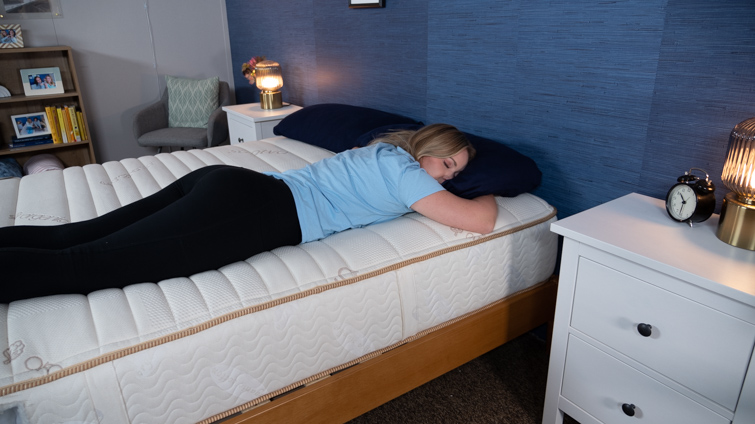
If you struggle with shoulder pain, it may seem counterintuitive to get a firmer mattress, but if your soft mattress is not providing adequate support, you’ll carry tension throughout your entire body. In fact, tension from improper sleep posture can be particularly noticeable in the shoulders. This doesn’t mean you need to swap a soft bed for a firm one, but it does mean that you need to consider a more supportive bed. If you deal with shoulder pain, we’d recommend opting for a mattress that’s soft enough to provide pressure relief, but supportive enough to align your spine in your chosen sleeping position.
Spinal Alignment Recap
Remember, it’s important to find a mattress that’s comfortable, but it’s equally important to find one that fits your preferred sleeping position. The goal is for your spine to be aligned into a perfectly straight line while you sleep. Otherwise, you can wake up in serious pain.
Pressure Relief
When we talk about a mattress’ pressure relief, I’m referring to how the bed distributes your body weight. Even weight distribution reduces tension throughout the body, which is particularly useful for those suffering from shoulder pain. The best pressure-relieving mattresses provide a comfortable resting place to soothe muscles and joints while simultaneously alleviating tension across the body.
To determine how a mattress ranks when it comes to pressure relief, make sure your bed isn’t putting pressure (or “pushing back”) on sensitive areas, such as your shoulders. Certain materials can be more pressure-relieving than others. For instance, soft memory foam beds can be ultra pressure-relieving, while firm innerspring mattresses won’t offer much pressure relief (or be good for sleepers with shoulder pain).
Sleeping Position
A mattress that supports your sleep posture will relieve tension throughout your body, which can help you relax your shoulders at night. Take a look at a few of the main sleeping positions below to learn more about what type of mattress suits each best.
- Side sleepers with shoulder pain generally do best on a soft mattress that offers plenty of body-contouring. You put a lot of pressure on the shoulders and hips when sleeping on your side, so you’ll want to look for a mattress with thick foam layers that will really cradle these joints.
- Back sleepers with shoulder pain should opt for a medium-soft to medium-firm mattress, according to a 2021 review. You’ll want something soft enough to allow some sinkage around the shoulders, but firm enough to support your lower back. No point in relieving shoulder pain on a soft mattress just to end up with lower back pain. If you’re a back sleeper with shoulder pain, we’d recommend looking for a bed that offers zoned support. These beds will feel softer at the shoulders to offer relief, but firmer at the hips and lower back to ensure you stay supported throughout the night.
- Stomach sleepers with shoulder pain should stick to a firm mattress to ensure they get appropriate support. A firm mattress that keeps their hips lifted up in line with their shoulders could actually relieve some pressure in the shoulder area, reducing pain. we’d recommend these folks opt for a firm mattress with a thin quilted pillow top that offers just a little pressure relief. We find firm latex mattresses with thin wool pillow tops very comfortable for stomach-sleeping.
- Combination sleepers with shoulder pain need appropriate support and pressure relief in all of the sleeping positions, but still need enough mobility to move around at night. In general, we’d recommend a medium-soft hybrid mattress to these folks. But, if you’re willing to sacrifice some mobility to relieve more pain, a soft all-foam mattress might be a better option.
Body Weight
You’ll also want to take your body weight into consideration when shopping for a mattress with shoulder pain.
We recognize that people come in all shapes and sizes, and people of every size deserve a mattress that works for their body type. We use the weight categories light, average, and heavy to more easily categorize sleepers based on how mattresses will perform for their body type, as most mattresses are designed for the group we call “average” (130 to 250 pounds).
Most online mattresses are built for people under 250 pounds. So heavier people with shoulder pain may want to opt for a slightly firmer mattress than they think they need to ensure they’re getting high-quality support. One of our best mattresses for heavy people could do the trick. If you’re a heavy person choosing from this list, we’d recommend the Loom & Leaf mattress, which features enough deep compression support to keep you comfortable.
On the other hand, lightweight people with shoulder pain should often opt for an even softer mattress than they think they need. Certain beds, especially memory foam mattresses, could feel firmer to these sleepers than they do to other folks. If you’re under about 130 lbs and deal with shoulder pain, we’d look for a foam mattress in the 5–5.5 range on the firmness scale.
You’re A Unique Sleeper
We already know that each person is unique, so it’s no surprise that each person sleeps a little differently, too. When shopping for a mattress, it’s important to consider what position you sleep in. But, keep in mind that your weight will also determine how far you sink into a mattress and how supportive it can be for you. What feels soft to you may feel firm to another sleeper.
Materials
Different mattress types offer more or less shoulder pain relief, so you’ll also want to pay close attention to the mattress materials you’re choosing. Take a look below to learn more about common mattress types’ pain-relieving capabilities.
- Memory foam mattresses are probably the best fit for those with shoulder pain. They offer tons of body-contouring and pressure relief, and have a slow response to pressure that allows you to sink into them. In general, we highly recommend sleepers who struggle with shoulder pain (or hip pain) check out memory foam mattresses.
- Polyfoam mattresses are also a good fit for sleepers with shoulder pain. Soft polyfoam beds are not as supportive or slow-moving as memory foam mattresses, but can be great budget options for relieving shoulder pain in the short term.
- Latex mattresses often feel bouncy and cooling. These beds don’t offer as much body-contouring as other foam mattresses, so side sleepers with shoulder pain may not get what they need. But soft latex mattresses could offer great relief for back sleepers with shoulder pain.
- Hybrid mattresses combine foam top layers with steel coils and can vary widely in feel. If you struggle with shoulder pain, we’d suggest looking for a hybrid with thick memory or polyfoam top layers that offer plenty of room for sinkage before transitioning into the coil support layer.
- Innerspring mattresses are generally not good fits for sleepers with shoulder pain. These beds have a traditional, bouncy feel and are often quite firm. A coil mattress without a thick top layer won’t offer quite enough pressure relief for sleepers with shoulder pain unless they sleep on their stomachs.
- Pillow top mattresses are usually hybrid or innerspring layers with an additional foam, wool, or occasionally down top layer. These beds can offer great pressure relief and feature a little extra sinkage. In general, pillow tops are very comfortable mattresses for sleepers with shoulder pain.
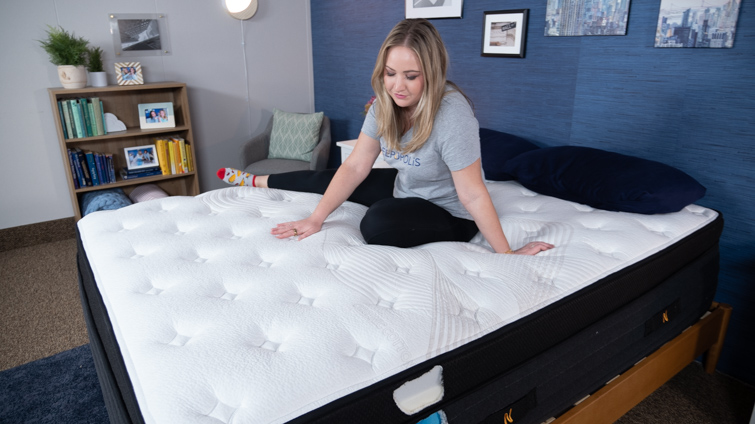
Body-Contouring
Body-contouring refers to the cradling or hug-like sensation you feel when the foams in a mattress conform to the shape of your body. Body-contouring can be especially helpful for sleepers with shoulder pain because it gently relieves overall tension, especially around sensitive joints. If you’re a back or side sleeper with shoulder pain, you may want to prioritize body-contouring, and memory foam mattresses tend to offer a lot of it.
Motion Isolation
Motion isolation refers to how well a mattress reduces disturbances throughout the night. If you sleep with a partner or pet, this is a measure of how much you’ll be jostled by their movements. If you struggle with shoulder pain, it can be hard to fall asleep. So you don’t want a mattress that it’s easy for your partner to accidentally wake you up on. You also don’t want an injured or sore shoulder to get disrupted overnight by a partner’s movements.
In general, memory foam and pillow top mattresses are good at isolating motion. Some of our best mattresses for couples also feature great motion isolation, and might be worth a look if this is a priority for you.
Cooling
Hot sleepers with shoulder pain can struggle to find a bed because memory foam and pillow top mattresses, which are some of the best out there for shoulder pain, often trap body heat. To help mitigate this issue, we’d recommend opting for a gel, copper, or graphite-infused memory foam bed if you already sleep hot. You may also want to consider a mattress that includes thermoregulating materials like wool or soft latex, or soft a hybrid bed whose coils promote airflow. Take a look at our best cooling mattresses to find a few more options.
Calling All Hot Sleepers
We’ve mentioned that memory foam tends to be a heat-trapping material, which usually is a big red flag for sleepers who run hot at night. But, don’t worry if you’re a hot sleeper who loves memory foam. Plenty of memory foam mattresses on the market have been designed to combat the natural heat-trapping quality of memory foam. Look for mattresses that are marketed as having “gel memory foam” or “aerated memory foam.”
Price
If you’re looking to save money when shopping for a new mattress, we’d recommend taking a look at our mattress coupon page and shopping during holiday sales like Black Friday or Memorial Day. If you’re planning to purchase a budget mattress, we’d recommend choosing one that offers a warranty and sleep trial period. Both options are great indicators that you’re purchasing from a reputable company that feels confident in their product.
Tips for Sleeping with Shoulder Pain
Now that you know how to choose the right mattress to combat shoulder pain, let’s talk a little bit about what else you can do to help alleviate pain at bedtime.
- Get a new pillow that ensures your head and neck are properly supported. This can help alleviate pressure at the shoulders and reduce pain. Check out our best pillows roundup to find a few options.
- Take an over-the-counter pain reliever before bed. Certain shoulder conditions can feel more inflamed or aggravated at night. An over-the-counter pain reliever or anti-inflammatory can help reduce some discomfort. Of course, speak with your doctor if there are certain medications you should avoid or you need to take a reduced dose.
- Side sleepers should try sleeping on the opposite shoulder as a way to reduce pain.
- Stretch and exercise regularly to improve shoulder pain over time.
- Try sleeping on your back if you don’t already. Back-sleeping is a great way to relieve shoulder pressure and pain. See our guide to training to sleep on your back.
- Back sleepers can try sleeping with an arm propped on a pillow. Elevating your arm could help take pressure off an injured or uncomfortable shoulder.
- Put a small pillow or rolled hand towel between your shoulder blades. This can relieve pressure across both shoulders. You can also try placing a pillow or towel under your painful shoulder while sleeping on your back to get the same result.
- Improve your overall sleep hygiene. Getting enough restful sleep can speed up recovery and help with pain. If you’re interested in improving your sleep hygiene, check out our 30-day sleep hygiene plan.
- Try a mattress topper. If you’re not ready to invest in a new mattress, a topper can add some much needed pressure relief to your existing bed. Take a look at some of the best mattress toppers, or take a look below to learn more about why a topper could help you.
When Should You Get A Mattress Topper?
Mattress toppers are a great invention for anyone who wishes to enhance their mattress without buying a completely new one. Like mattresses, there are many different types of mattress toppers on the market that are made with different materials and firmness levels. Sometimes, all you need is a mattress topper to turn a good mattress into a great mattress.
Best Mattress Toppers for Shoulder Pain
If you’re sleeping on a bed that’s too firm, or even a new mattress you haven’t quite broken in yet, a soft topper can do a lot to relieve shoulder pain and pressure. Or, if you’ve already got a great, supportive mattress that you don’t want to part with, but need a bit more pressure relief, a topper is likely the best option for you.
Toppers are also much more affordable than a new mattress, which can be a nice perk for shoppers on a budget. Plus, if you struggle with shoulder pain but aren’t sure if a new mattress would help, a topper is a great way to see if some additional cushioning could be beneficial without spending a lot of money.
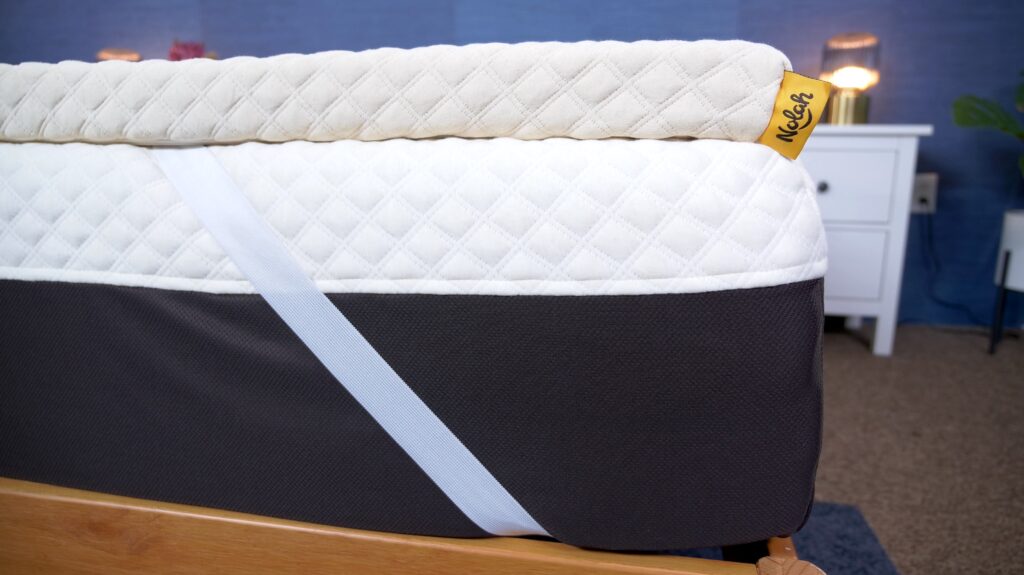
In general, we’d recommend looking for soft memory foam mattress toppers that offer a mix of body-contouring and pressure relief if you’re looking to address shoulder pain. Our best soft mattress toppers and best memory foam mattress toppers roundups are great places to find some toppers that might work for your needs.
Best Mattresses for Shoulder Pain Summary
That’s a wrap for the best mattress for shoulder pain guide. No matter the mattress you choose, keeping these tips in mind will help you determine which mattress most effectively offers you shoulder pain relief. Again, please only use this guide as an informational resource. We’re not licensed medical professionals, so be sure to contact your doctor with any persistent health issues.
FAQs
Is a soft or firm mattress better for shoulder pain?
For shoulder pain, the best firmness depends on one’s sleeping position. Side sleepers will likely want a soft mattress because they put a lot of pressure on their hip and shoulder at night. A soft mattress can contour to these sensitive joints and minimize pressure buildup. Back and stomach sleepers will likely want something a bit firmer because they don’t want to sacrifice too much support. But they should consider a comfort layer thick enough to cradle the shoulders.
What is the best type of mattress for neck and shoulder pain?
The type of mattress you’ll want depends on your body weight, sleeping position, and overall preferences. From there, you’re likely to find a mattress that cradles the shoulders while also supporting your spine and neck in proper alignment. For instance, side sleepers might want a cushioning memory foam mattress because they put the most pressure on the shoulder. Heavier stomach sleepers might want to go for a super supportive hybrid with a little pressure relief that keeps the spine in alignment and alleviates neck and shoulder pain.
What position is best for sleeping with shoulder pain?
We recommend back sleeping for shoulder pain, since there isn’t a lot of pressure put on the shoulders and weight is distributed more evenly. Stomach sleeping can be problematic in terms of proper spinal alignment, and side sleeping definitely puts the most pressure on the shoulders. We recommend trying to transition out of side and stomach sleeping if possible.
Can a mattress cause shoulder pain?
Yes, a mattress can exacerbate and in some cases even cause shoulder pain. For instance, if you’re a side sleeper resting on a super firm mattress without much of a comfort layer, it can put far too much pressure on the shoulder. This can result in new or worse shoulder pain.
How We Chose These Mattresses
Our team of Certified Sleep Science Coaches has reviewed more than 220 products in our mattress lab, running each one through tests such as pressure-mapping and measuring motion transfer with a seismometer. From there, we give every bed an overall score based on materials, comfort, support, cooling, and edge support. We also factor in brand performance with categories such as value and warranty.
Sleepers who experience shoulder pain are going to need different things from a mattress depending on their body type and sleeping position. So we took various categories into account when choosing beds for this roundup. For instance, side sleepers tend to need a lot of pressure relief on their shoulders, so we picked a mattress that scored a high 4 out of 5 on comfort for this superlative. Back sleepers, on the other hand, need more support, so we chose a bed that scored a 4.5 out of 5 on support for that superlative. Jump back to our mattress picks or click here to learn more about our methodology.
Best Mattresses for Shoulder Pain 2024
| Mattress | Best For | Price (Queen) | Coupon | Review |
|---|---|---|---|---|
| Puffy Royal Hybrid | Overall | $3,149 | Puffy Coupon | Read Our Review |
| Helix Sunset Luxe | Neck and Shoulder Pain | $2,374 | Helix Coupon | Read Our Review |
| Loom & Leaf | Side Sleepers | $2,395 | Loom & Leaf Coupon | Read Our Review |
| DreamCloud | Cooling | $1,199 | DreamCloud Coupon | |
| WinkBed | Hybrid | $1,799 | WinkBed Coupon | Read Our Review |
| Titan Plus Luxe | Heavy People | $1,599 | Brooklyn Bedding Coupon Coupon | Read Our Review |
| Nolah Signature | Back Sleepers | $1,799 | Nolah Coupon | Read Our Review |
| Bear Elite Hybrid | Athletes | $2,111 | Bear Coupon | Read Our Review |
| Brooklyn Bedding Signature Hybrid | Couples | $1,732 | Brooklyn Bedding Coupon | Read Our Review |
| Nectar | Memory Foam | $1,049 | Nectar Coupon | Read Our Review |
Sources
Caggiari Gianfilippo. What type of mattress should be chosen to avoid back pain and improve sleep quality? Review of the literature. Journal of Orthopaedic Trauma. 2021. https://jorthoptraumatol.springeropen.com/articles/10.1186/s10195-021-00616-5
Jacbson Bert, H. Effect of prescribed sleep surfaces on back pain and sleep quality in patients diagnosed with low back and shoulder pain. Applied Ergonomics. 2010. https://www.sciencedirect.com/science/article/abs/pii/S0003687010000724?via%3Dihub
Stutz Jan. Effects of evening exercise on sleep in healthy adults: a systematic review and meta-analysis. Sports Medicine. 2018. https://link.springer.com/article/10.1007/s40279-018-1015-0

